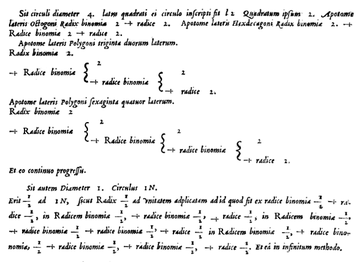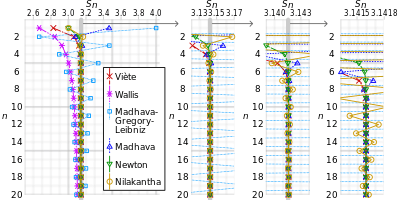Viète's formula
In mathematics, Viète's formula is the following infinite product of nested radicals representing the mathematical constant π:

It is named after François Viète (1540–1603), who published it in 1593 in his work Variorum de rebus mathematicis responsorum, liber VIII.[1]
Significance
At the time Viète published his formula, methods for approximating π to (in principle) arbitrary accuracy had long been known. Viète's own method can be interpreted as a variation of an idea of Archimedes of approximating the length of a circle by the perimeter of a many-sided polygon,[1] used by Archimedes to find the approximation
However, by publishing his method as a mathematical formula, Viète formulated the first instance of an infinite product known in mathematics,[2][3] and the first example of an explicit formula for the exact value of π.[4][5] As the first formula representing a number as the result of an infinite process rather than of a finite calculation, Viète's formula has been noted as the beginning of mathematical analysis[6] and even more broadly as "the dawn of modern mathematics".[7]
Using his formula, Viète calculated π to an accuracy of nine decimal digits.[8] However, this was not the most accurate approximation to π known at the time, as the Persian mathematician Jamshīd al-Kāshī had calculated π to an accuracy of nine sexagesimal digits and 16 decimal digits in 1424.[7] Not long after Viète published his formula, Ludolph van Ceulen used a closely related method to calculate 35 digits of π, which were published only after van Ceulen's death in 1610.[7]
Interpretation and convergence
Viète's formula may be rewritten and understood as a limit expression
where an = √2 + an − 1, with initial condition a1 = √2.[9] Viète did his work long before the concepts of limits and rigorous proofs of convergence were developed in mathematics; the first proof that this limit exists was not given until the work of Ferdinand Rudio in 1891.[1][10]

The rate of convergence of a limit governs the number of terms of the expression needed to achieve a given number of digits of accuracy. In the case of Viète's formula, there is a linear relation between the number of terms and the number of digits: the product of the first n terms in the limit gives an expression for π that is accurate to approximately 0.6n digits.[8][11] This convergence rate compares very favorably with the Wallis product, a later infinite product formula for π. Although Viète himself used his formula to calculate π only with nine-digit accuracy, an accelerated version of his formula has been used to calculate π to hundreds of thousands of digits.[8]
Related formulas
Viète's formula may be obtained as a special case of a formula given more than a century later by Leonhard Euler, who discovered that:
Substituting in this formula yields:
Then, expressing each term of the product on the right as a function of earlier terms using the half-angle formula:
gives Viète's formula.[1]
It is also possible to derive from Viète's formula a related formula for π that still involves nested square roots of two, but uses only one multiplication:[12]
which can be rewritten compactly as
Many formulae similar to Viète's involving either nested radicals or infinite products of trigonometric functions are now known for π and other constants such as the golden ratio.[3][12][13][14][15][16][17][18]
Derivation

Viète obtained his formula by comparing the areas of regular polygons with 2n and 2n + 1 sides inscribed in a circle.[1][6] The first term in the product, √2/2, is the ratio of areas of a square and an octagon, the second term is the ratio of areas of an octagon and a hexadecagon, etc. Thus, the product telescopes to give the ratio of areas of a square (the initial polygon in the sequence) to a circle (the limiting case of a 2n-gon). Alternatively, the terms in the product may be instead interpreted as ratios of perimeters of the same sequence of polygons, starting with the ratio of perimeters of a digon (the diameter of the circle, counted twice) and a square, the ratio of perimeters of a square and an octagon, etc.[19]
Another derivation is possible based on trigonometric identities and Euler's formula. By repeatedly applying the double-angle formula
one may prove by mathematical induction that, for all positive integers n,
The term 2n sin x/2n goes to x in the limit as n goes to infinity, from which Euler's formula follows. Viète's formula may be obtained from this formula by the substitution x = π/2.[4]
References
- Beckmann, Petr (1971). A history of π (2nd ed.). Boulder, CO: The Golem Press. pp. 94–95. ISBN 978-0-88029-418-8. MR 0449960.
- De Smith, Michael J. (2006). Maths for the Mystified: An Exploration of the History of Mathematics and Its Relationship to Modern-day Science and Computing. Troubador Publishing Ltd. p. 165. ISBN 9781905237814.
- Moreno, Samuel G.; García-Caballero, Esther M. (2013). "On Viète-like formulas". Journal of Approximation Theory. 174: 90–112. doi:10.1016/j.jat.2013.06.006. MR 3090772.
- Morrison, Kent E. (1995). "Cosine products, Fourier transforms, and random sums". The American Mathematical Monthly. 102 (8): 716–724. arXiv:math/0411380. doi:10.2307/2974641. JSTOR 2974641. MR 1357488.
- Oldham, Keith B.; Myland, Jan C.; Spanier, Jerome (2010). An Atlas of Functions: with Equator, the Atlas Function Calculator. Springer. p. 15. ISBN 9780387488073.
- Maor, Eli (2011). Trigonometric Delights. Princeton University Press. pp. 50, 140. ISBN 9781400842827.
- Borwein, Jonathan M. (2013). "The Life of Pi: From Archimedes to ENIAC and Beyond". From Alexandria, Through Baghdad: Surveys and Studies in the Ancient Greek and Medieval Islamic Mathematical Sciences in Honor of J.L. Berggren (PDF). Springer. ISBN 9783642367359.
- Kreminski, Rick (2008). "π to Thousands of Digits from Vieta's Formula". Mathematics Magazine. 81 (3): 201–207. doi:10.1080/0025570X.2008.11953549. JSTOR 27643107.
- Eymard, Pierre; Lafon, Jean Pierre (2004). "2.1 Viète's infinite product". The Number π. American Mathematical Society. pp. 44–46. ISBN 9780821832462.
- Rudio, F. (1891). "Über die Konvergenz einer von Vieta herrührenden eigentümlichen Produktentwicklung". Z. Math. Phys. 36: 139–140.
- Osler, T. J. (2007). "A simple geometric method of estimating the error in using Vieta's product for π". International Journal of Mathematical Education in Science and Technology. 38 (1): 136–142. doi:10.1080/00207390601002799.
- Servi, L. D. (2003). "Nested square roots of 2". The American Mathematical Monthly. 110 (4): 326–330. doi:10.2307/3647881. JSTOR 3647881. MR 1984573.
- Nyblom, M. A. (2012). "Some closed-form evaluations of infinite products involving nested radicals". The Rocky Mountain Journal of Mathematics. 42 (2): 751–758. doi:10.1216/RMJ-2012-42-2-751. MR 2915517.
- Levin, Aaron (2006). "A geometric interpretation of an infinite product for the lemniscate constant". American Mathematical Monthly. 113 (6): 510–520. doi:10.2307/27641976. JSTOR 27641976. MR 2231136.
- Levin, Aaron (2005). "A new class of infinite products generalizing Viète's product formula for π". Ramanujan Journal. 10 (3): 305–324. doi:10.1007/s11139-005-4852-z. MR 2193382.
- Osler, Thomas J. (2007). "Vieta-like products of nested radicals with Fibonacci and Lucas numbers". The Fibonacci Quarterly. 45 (3): 202–204. MR 2437033.
- Stolarsky, Kenneth B. (1980). "Mapping properties, growth, and uniqueness of Vieta (infinite cosine) products". Pacific Journal of Mathematics. 89 (1): 209–227. doi:10.2140/pjm.1980.89.209. MR 0596932. Archived from the original on 2013-10-11. Retrieved 2013-10-11.
- Allen, Edward J. (1985). "Continued radicals". Mathematical Gazette. 69 (450): 261–263. doi:10.2307/3617569. JSTOR 3617569.
- Rummler, Hansklaus (1993). "Squaring the circle with holes". The American Mathematical Monthly. 100 (9): 858–860. doi:10.2307/2324662. JSTOR 2324662. MR 1247533.
External links
- Viète's Variorum de rebus mathematicis responsorum, liber VIII (1593) on Google Books. The formula is on the second half of p. 30.